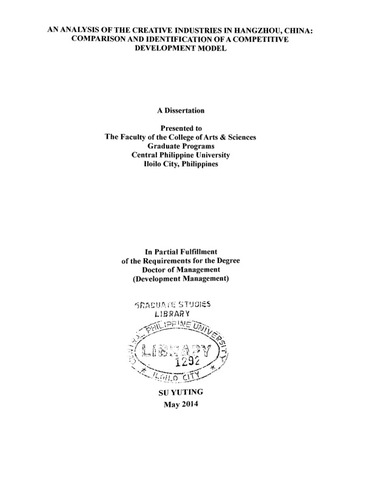Ipakita ang simpleng tala ng item
An analysis of the creative industries in Hangzhou, China: Comparison and identification of a competitive development model
| dc.contributor.adviser | David, Fely P. | |
| dc.contributor.author | Su, Yuting | |
| dc.coverage.spatial | Hangzhou | en_US |
| dc.date.accessioned | 2022-03-11T02:58:54Z | |
| dc.date.available | 2022-03-11T02:58:54Z | |
| dc.date.issued | 2014 | |
| dc.identifier.citation | Su, Y. (2014). An analysis of the creative industries in Hangzhou, China: Comparison and identification of a competitive development model (Unpublished Doctoral dissertation). Central Philippine University, Jaro, Iloilo City. | en_US |
| dc.identifier.uri | https://hdl.handle.net/20.500.12852/1969 | |
| dc.description | Abstract only | en_US |
| dc.description.abstract | With the increasing integration of knowledge and technology in the 21st century, the creative industry has emerged as a new growth polar to enhance the competitiveness of a city or even a country. In terms of the strategic role of creative industries in economic development, some international metropolis in China pay a lot of attention to creative industries and take them as another growth polar. Following the footstep of Hongkong, Beijing and Shanghai, Hangzhou has also realized the significance of developing creative industries. Although there are lots of opportunities in Hangzhou to develop creative industries, and it has also made great progress in the past few years, it is still apparent that there are big gaps between Hangzhou and other foreign developed regions. For example, the impeccable public service platform in Hangzhou has not been formed yet, the industry chain has not been integrated, and the investment and financing system has not been built yet. Moreover, the Hangzhou creative industries have not yet built distinct competitive advantages. Although existing research on Hangzhou creative industries has attracted certain attention on the theoretical area, most studies mainly focus on the questions on how to cultivate creative talents for Hangzhou creative industry, how to cluster and enhance the competitiveness of Hangzhou creative industry, how to design and construct the creative park, and how to develop scientific policies. Up to now, research on Hangzhou creative industry has not paid enough attention to the study of development models, and in the design of a model that will match Hangzhou’s cultural and geographical features. In view of this, there is need to establish a theoretical analysis tool to analyze the current situation and select a scientific development model for Hangzhou’s creative industries, and enact some development policies for Hangzhou creative industries. Firstly, based on the development tendency of creative industries in some big cities of developed countries and at home, and the current conditions of creative industries in Hangzhou, it is necessary to do research on a development modes for creative industries of Hangzhou. Secondly, there is need to review the definition and characteristics of creative industries, to identify and develop a development model based on theories about industry competitiveness. Thirdly, this study attempted to analyze the development of creative industries of Hangzhou using the diamond model, and comparing this with the models used America, Britain, South Korea and Japan, and in developed cities in China, like Beijing and Shanghai. Based on the comparisons, an appropriate development model was selected based on the analysis results and the experiences of other cities abroad and at home. Lastly, measures that can ensure healthy and sustainable development of creative industries of Hangzhou were identified. It is argued that Hangzhou creative industries should be provided government support, adopt enterprise cooperation, engage in industrial cluster development, and utilize assistance of universities and research institutions. The government should actively guide and support the industry, allowing it to participate in market competition, by allocating resources for the enterprises to give them opportunities to be competitive market players. Industrial parks should explore suitable management models, and form smooth, efficient industrial chain. Moreover, universities and research institutions should develop high-tech talents for the market and enterprise. To do this, they should enhance their research and development capabilities, and improve their level of independent innovation. Therefore, the development model of creative industries in Hangzhou should have full government support, enterprise cooperation, industrial cluster development, and assistance from universities and research institutions. | en_US |
| dc.format.extent | 120 leaves | en_US |
| dc.language.iso | en | en_US |
| dc.subject.ddc | GSL Theses 658.0072 Su1 | en_US |
| dc.subject.lcsh | Industries | en_US |
| dc.subject.lcsh | City planning | en_US |
| dc.subject.lcsh | Cities and towns--Growth | en_US |
| dc.subject.lcsh | China--Hangzhou Shi | en_US |
| dc.title | An analysis of the creative industries in Hangzhou, China: Comparison and identification of a competitive development model | en_US |
| dc.type | Thesis | en_US |
| dcterms.accessRights | Not publicly accessible | en_US |
| dc.description.bibliographicalreferences | Includes bibliographical references | en_US |
| dc.contributor.chair | Crucero, Teresita E. | |
| dc.contributor.committeemember | Gumban, Gynnyn G. | |
| dc.contributor.committeemember | Delicana, Lilia A. | |
| dc.contributor.committeemember | Dusaran, Reynaldo N. | |
| dc.contributor.department | School of Graduate Studies | en_US |
| dc.description.degree | Doctor of Management (Developmental Management) | en_US |
| local.subject | Creative industry | en_US |


